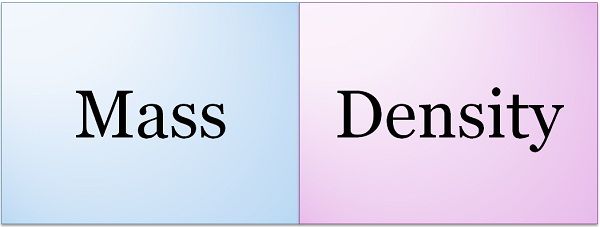 When you look around, you will find an array of objects with different size, shape and texture. These objects are made up of matter, which is present in three forms i.e. solid, liquid and gas. All three states of matter possess two things in common, which are mass and volume. Mass is the quantity of matter while volume is the measure of space occupied by the object. The ratio of these two aspects of the matter is known as density.
When you look around, you will find an array of objects with different size, shape and texture. These objects are made up of matter, which is present in three forms i.e. solid, liquid and gas. All three states of matter possess two things in common, which are mass and volume. Mass is the quantity of matter while volume is the measure of space occupied by the object. The ratio of these two aspects of the matter is known as density.
The measurement unit of mass is a kilogram, whereas the density is measured in kilogram per cubic meter. The article presented to you, explains the difference between mass and density in a detailed manner, so have a look.
Content: Mass Vs Density
Comparison Chart
| Basis for Comparison | Mass | Density |
|---|---|---|
| Meaning | Mass implies amount of matter contained in an object. | Density of an object alludes to the concentration of matter in an object. |
| What is it? | It is a measure of inertia. | It is the degree of compactness. |
| Property | Extrinsic | Intrinsic |
| Represent | Matter present in a body. | Mass present per unit volume. |
| SI unit | Kilogram | Kilogram per cubic metre |
Definition of Mass
The term ‘mass’ can be understood as the measurement of the amount of matter present in something, i.e. how much substance is there in the object. The more the matter contained by an object, the greater is its mass. It is measured in kilogrammes or its derived units.
Mass is a scalar quantity, based on the inertia. Inertia is the resistance of an object, to change its state of motion when the force is applied to it. Therefore, an object with greater mass has higher tendency to resist acceleration. The mass of an object determines the heaviness of an object without gravity, meaning that it remains constant because mass does not change with the change in place at a given moment of time.
Definition of Density
Simply put, density is described as that amount of mass present in a substance for a given volume. It is the basic characteristic of a substance, that explains the relationship between mass and volume (space occupied). It determines how tightly molecules of an object are packed into the given amount of space.
The density of an object remains same, irrespective of its shape and size. Although, it can be changed if temperature and pressure are applied to the object, but the change in density results in the change in substance too.
The reason for sinking or floating of most of the objects is their density, as in the objects which are less dense tend to float, while the object with higher density tends to sink.
Key Differences Between Mass and Density
The following points are substantial so far as the difference between mass and density is concerned:
- The term mass is used to mean the amount of matter contained in an object. Density alludes to the closeness of the atoms, in substance, i.e. how tightly atoms are packed.
- Mass is the measure of the amount of inertia. Conversely, density is the degree of compactness.
- Mass of an object is the extrinsic property that depends on the matter present in the substance. On the contrary, the density of an object implies the intrinsic property of an object which is not based on the quantity of matter existing in the sample.
- Mass represents the quantity of matter present in an object. As against this, density indicates the mass present per unit volume.
- The unit of measurement of mass is a kilogram, whereas the standard unit of density as per International Standard is kilogramme per cubic metre.
Conclusion
In science, mass and density are the two basic concepts, which are studied along but are very different from one another. Both mass and density are the scalar quantity, that has mass but no direction. Mass of an object describes how heavy an object is, irrespective of gravity, but density describes how compact the mass of an object, per unit volume.






Jacob Tom says
Thank you.
A Valuable information